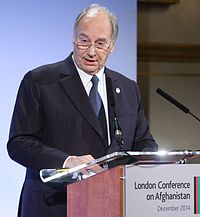Aga Khan
| Aga Khan of Nizari Ismaili Shias | |
|---|---|
| آقاخان | |
| Incumbent | |
 His Highness the Aga Khan IV the current holder of this title. | |
| Shah Karim al-Husseini | |
| Details | |
| Style | Imam Aga Khan Your Highness |
| First monarch | Hasan Ali Shah |
| Part of a series on Islam Isma'ilism |
|---|
 |
|
|
Aga Khan (Persian: آقاخان; also transliterated as Aqa Khan and Agha Khan[1]) is a title used also as a name by the Imam of the Nizari Ismailis, whose current holder is the 49th Imam (1957–present), Prince Shah Karim Al Husseini Aga Khan IV (b. 1936).
The title is made up of the titles agha and khan. The Turkish "agha" is "aqa" (Āqā) in Persian. The word "agha" comes from the Old Turkic and Mongolian "aqa", meaning "elder brother",[2][3] and "khan" means king, ruler in Turkic and Mongolian languages.[4]
According to Farhad Daftary,[5] a scholar of the Ismaili movement, Aga Khan is an honorific title bestowed on Hasan Ali Shah (1800–1881), the 46th Imam of Nizari Ismailis (1817–1881), by Persian king Fath-Ali Shah Qajar.[6] However, Daftary apparently contradicts what the Aga Khan III noted in a famous legal proceeding in India: that Aga Khan is not a title but instead a sort of alias that was given to the Aga Khan I when he was a young man.[7]
During the latter stages of the First Anglo-Afghan War (1841–1842), Hasan Ali Shah and his cavalry officers provided assistance to General Nott in Kandahar Province and to General England in his advance from Sindh to join Nott.[citation needed] He was awarded the status of "Prince" by the British government's representatives in India and became the only religious or community leader in British India granted a personal gun salute;[citation needed] When Hasan Ali Shah, the first Aga Khan, came to Sindh, which is now in Pakistan, from Afghanistan, he and his army were welcomed by Mir Nasir Khan of Baluchistan, Pakistan.[citation needed] In 1866, the Aga Khan won a court victory in the High Court of Bombay in what popularly became known as the Aga Khan Case, securing his recognition by the British government as the head of the Khoja community. The Aga Khan is also the Pir within the Nizari Ismaili community.
In 1887, the Secretary of State for India acting through the Viceroy of India, formally recognized the title Aga Khan.[citation needed]
These four persons have had this title:
- Aga Khan I – Hasan Ali Shah Mehalatee (1804–1881), 46th Imam of Nizari Ismailis (1817–1881)
- Aga Khan II – Ali Shah (about 1830–1885), 47th Imam of Nizari Ismailis (April 12, 1881 – August 1885)
- Aga Khan III – Sir Sultan Mohammed Shah (1877–1957), 48th Imam of Nizari Ismailis (August 17, 1885 – July 11, 1957)
- Aga Khan IV – Prince Shah Karim Al Husseini (b. 1936), 49th Imam of Nizari Ismailis (July 11, 1957 – present)
References
- ^ Daftary, Farhad (2007). The Ismailis: Their History and Doctrines Second Ed. Cambridge: Cambridge University Press. ISBN 978-0-511-35561-5.
{{cite book}}: Check|first=value (help) - ^ "the definition of aga". Dictionary.com. Retrieved June 17, 2016.
- ^ "imla". www.nisanyansozluk.com. Retrieved June 17, 2016.
- ^ Fairbank, John King (1978). The Cambridge History of China. Cambridge University Press. p. 367.
- ^ "The Institute of Ismaili Studies". Archived from the original on May 12, 2013. Retrieved April 2, 2013.
{{cite web}}: Unknown parameter|deadurl=ignored (|url-status=suggested) (help) - ^ Daftary, Farhad (2004). Ismaili Literature: A Bibliography Of Sources And Studies. Institute of Ismaili Studies. ISBN 978-1-850-43439-9.
{{cite book}}: Check|first=value (help) - ^ Russell, Sir Justice. "Bombay High Court:Haji Bibi vs H.H. Sir Sultan Mahomed Shah 1 September 1908". High Court of Bombay. Retrieved March 31, 2013.
See also
- List of Ismaili imams
- Imamah (Shi'a doctrine)
- Ismā'īlī
- Nizārī Ismā'īlī
- Imamah (Nizari Ismaili doctrine)
Further reading
- "Les Agas Khans", Yann Kerlau, Perrin 2004
